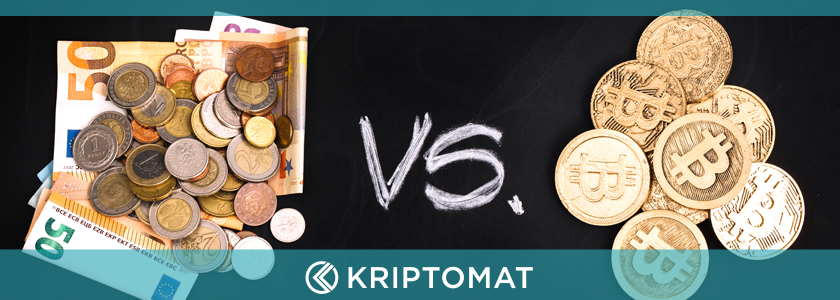You might think that bitcoin doesn’t actually exist in any tangible form, and you’d be completely right! The title of this blog post is a bit provocative and with good intentions.
How can bitcoin be trusted more than euro? Is a tangible form of money really an important element of the monetary system? In this blog post, I will try to make you rethink your outlook about cryptocurrencies and explain why I believe bitcoin is the new revolution.
Let us explain.
What is Bitcoin?
We’ve already talked at length about the various technical aspects of bitcoin in our previous blog posts, so we invite you to read those as well, especially if you are a beginner. If you are already familiar with the subject, you can skip those, and continue reading.
- What Is Bitcoin – Everything You Need to Know
- What Is Blockchain Technology and How Does It Work?
- What Is Bitcoin and Where Can You Buy It? An Infographic!
- What Is Bitcoin Mining – What You Need to Know About Mining Cryptocurrencies
- Cash Savings Versus Bitcoin Savings

If we condense Bitcoin down to its essence, we can say that it consists of a universal database, called the blockchain, and a network of people who maintain it, called the miners.
The blockchain records transactions and the miners add the blocks to the blockchain.
A bitcoin is a string of electronic data that cannot be duplicated because it is an entry on the blockchain, which is simply a public ledger that contains a collection of financial accounts. When a transaction is recorded, it remains on the blockchain forever.
To summarize, blockchain is a string of transactions, each referring to an earlier record in the chain, all the way back to the very first (aka genesis) block. In order to make a transaction, you have to create a request and broadcast it over the worldwide peer-to-peer Bitcoin Network. The miners then use their hardware to make sure that everything is in order. The transaction (along with a number of other transactions) is then packaged into a block and added to the blockchain.
Data can’t be faked, and there is no double-spending. The latter is a big contributor in favor of bitcoin.
What does bitcoin solve?
It could be any number of things in addition to the already mentioned double-spending problem, but I want to focus on the fact that only people who own bitcoin can spend them and no one can create new bitcoins.
Well, technically they are created out of thin air in the process of solving complex mathematical puzzles, but there will never be more than 21 million coins.
You can think of this number as being hard-coded into the system. The supply is fixed, so it could be argued that it is a deflationary currency. There’s another argument in favor of bitcoin.
But bitcoin is still not backed by anything. It is backed by belief — or faith — into the currency itself. In that sense, it is just an illusion. But I will argue that the euro is no different.

Euro and what is fiat money?
The euro you use in your everyday life is what we would call a fiat currency. Fiat is Latin for “let there be,” as in “fiat lux” or “let there be light”. In our case, “let there be euro”. It’s a good choice of words as it correctly implies that the money you hold in your pocket is little more than a nicely printed piece of paper, and the money you hold in your bank is little more than numbers in an elaborate spreadsheet.
Hundreds of millions of euros are printed every year and no one can tell you how much money will be in circulation in the future. As we mentioned in our previous blog post, 90% of world money today exists purely in digital form, and a similar percentage can be attributed to the euro. There is little any regular person can do to prevent new money being created out of thin air. One obvious result of this is inflation.
Like bitcoin, the euro also isn’t backed by anything. It is backed by mass belief — or faith — into the currency itself. It’s the belief of people and positive regulatory environment that it will be accepted as payment. In that sense, it is just a symbol (or an illusion) of some value.
What is the difference between bitcoin and the euro?
You don’t need to be a detective to know where I’m going with this. If we go all the way down to the bare essentials, we can say the faith in euro is bigger simply because it is a currency that is more widely accepted, and most importantly, regulated.
Will this ever change? Naturally, some people believe so and others don’t. There are many arguments against bitcoin, particularly from the established figures in the world of finance, but that is not to say that the euro doesn’t have its own issues.
As the Bitcoin Network operates in a peer-to-peer fashion via the blockchain, there are no middlemen or central institutions in between to process the transaction, which results in a fast transfer of digital money and lower costs of those transactions. More to that, as we described above, the technology itself is stable, trustful and the data on the blockchain is irreversible. And this is something that the euro cannot do.
These are the factors that may at some point place Bitcoin (or another cryptocurrency) on the map as the main medium of exchange. Whenever you want to enter the world of cryptocurrencies in a safe and easy way, register to Kriptomat.
Join the discussion on our social media!
Twitter | Facebook | LinkedIn | Telegram | Reddit | Instagram | YouTube
NOTE
This text is informative in nature and should not be considered an investment recommendation. It does not express the personal opinion of the author or service. Any investment or trading is risky, and past returns are not a guarantee of future returns. Risk only assets that you are willing to lose.




 IOS
IOS Android
Android